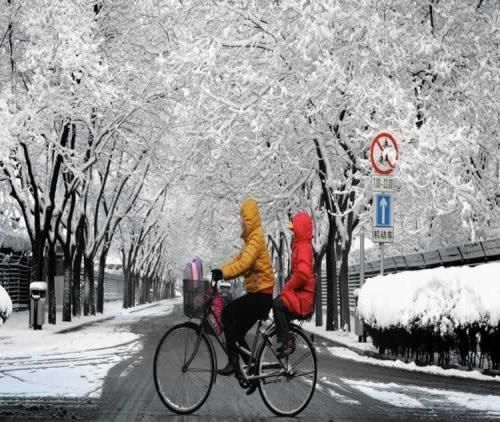洛杉矶时报:中国供暖分界线是“时代错误”
 中国供暖分界线
中国供暖分界线Growing up in Mao Tse-tung’s hometown of Shaoshan in southern China, Tan Huiyan remembers the wintertime sensation of stepping inside through her front door — and into the cold. “People in my hometown always say it’s colder in your home than outside in winter,” recalled Tan, 31, who now lives in Beijing.
在毛泽东故乡韶山长大的谭慧燕(音),仍记得冬天走进其家门时的感觉:冷。“我们老家的人总是说,冬天的家里比外面还冷,回到家里就得穿上更保暖的衣服。”现在31岁,目前生活在北京的谭女士回忆道。
“When I came home, I had to change into warmer clothes. After taking off my winter jacket, I had to put on very thick and padded pajamas. My Nike sneakers were not warm enough to be used at home, I always had to change into boots with furs inside, like those UGG boots。”
“我回家的时候必须换更暖和的衣服。换下冬装夹克,穿上厚厚的棉睡衣。在家耐克运动鞋不够暖和,我必须穿带毛的靴子,比如UGG的雪地靴。”
Temperatures in Shaoshan can dip to as low as minus 5 degrees in January, and the average is around 7.8 degrees from December to February. But a key dividing line — established almost 60 years ago — bisects China into wintertime central heating haves and have-nots, and Tan was on the wrong side of it。
韶山的气温在一月份可下降至低至零下5摄氏度,十二月到二月份的平均气温为7.8度。大约60年前划定的一条关键的分界线把中国分成了两部分,一方为集中供暖区,一方不集中供暖。谭女士很不幸在分界线以南。
On Saturday, and every Nov. 15, people who live in apartment complexes in Beijing, Harbin and hundreds of other cities north of the boundary will rejoice as government central heating plants are fired up, flooding warmth into citizens’ abodes for four months. Those who live south of the line — even by a mile — will suffer the season with nary a puff of steam from a radiator。
上周六,也就是每年的11月15日,住在北京,哈尔滨和其他数百个位于分界线以北的城市的公寓楼里的人们欢欣雀跃,因为政府的集中采暖设备开始工作,在未来的四个月把温暖送到千家万户。那些住在分界线以南,哪怕一英里的人们只能这样生生挨过一整个冬天。
The great heating divide, which traces the Huai River and Qin Mountains near the latitude 33 degrees north, dates from the 1950s. Back then, China started to install centralized systems for residential areas with assistance from the Soviet Union. But China was facing an extreme energy shortage in those years, and Premier Zhou Enlai suggested the Qin-Huai line, a well-known demarcation between north and south, as a cutoff point。
这条以北纬33度附近的淮河、秦岭为分界的南北供暖线可以追溯到上世纪50年代。当时,在苏联的帮助下,中国开始为住宅区安装集中供暖系统。但是,当时中国能源极度短缺。周恩来总理建议,以众所周知的南北分界秦岭、淮河划分。
The divide was not ironclad. The Huai River runs through Xinyang in Henan province, but because more than 75% of the people live south of the river, the city was left out of the heating club. About 66 miles north, Zhumadian in Henan enjoys central heat. But go 43 miles north to Luohe, and there are no radiators in sight。
这条南北线就这样延续至今。淮河流经河南信阳,但是因为信阳75%以上的人口都居住在淮河南岸,这座城市就这样被排除在外。而在淮河以北约66英里的驻马店就享受着集中供暖。但在再往北43英里的漯河,就没有供暖。
It’s not an easy inequity to resolve, perhaps made all the more difficult this week by the announcement of an agreement between China and the U.S. to curb greenhouse gas emissions. If China took the unlikely step of providing central heating to all the residential urban areas in the south, it would need to burn an additional 50 million tons of coal each year, Jiang Yi, director of a building energy research center at Tsinghua University, told the Beijing News。
这种不平等并不容易解决。这周中国和美国签订的遏制温室气体排放的协议让一切更加困难。清华[微博]大学[微博]建筑节能研究中心主任蒋毅告诉新京报记者,尽管不太可能发生,但如果中国给南方所有住宅区提供集中供暖,每年需要增加50亿吨标准煤的消耗。
Unlike the U.S., where housing codes typically require residential buildings to meet certain indoor temperature minimums in cold weather, Chinese cities do not have such standards. In areas where the government doesn’t provide central heating for the whole city, residents are left to deal with the cold on their own. Historically, many northern residents would have a kang, a brick bed heated by wood burned underneath it. But southerners had no such tradition。
美国的住房规定通常要求住宅楼在寒冷的天气达到一定的室内温度,而中国的城市没有这样的标准。在政府没有提供集中供暖的地区,居民只能自己对抗寒冷。历史上,许多北方居民都有炕,就是一张砖做的床,下面烧木头,但南方人没有这样的传统。
These days, with economic growth raising standards of living and private developers building homes and apartments, the Qin-Huai line is increasingly considered anachronistic, inconvenient and even inhumane. Some cities have experienced blackouts because so many people are plugging in space heaters。
现在,随着经济发展人的生活水平提高了,私营开放商建造房屋和公寓,秦淮分界线越来越被认为是一个“时代错误”,不方便甚至不人道。一些城市因为太多人使用加热器被迫停电。
Two years ago, a member of the National Committee of the Chinese People’s Political Consultative Conference submitted a proposal to extend the heat southward. And a writer for the Communist-run newspaper last year reiterated the call. “We are no longer a country in shambles,” wrote Shu Meng. “The Chinese government has the ability to let more people live in warm conditions in the winter。”
两年前,一位政协委员提交了一份提案,建议供暖向南延伸。一位党报作者去年再次呼吁。舒梦(音)写道,“我们不再是一个混乱的国家,中国政府有能力让更多的人在冬季生活在温暖中。”
Tan, who moved to Beijing in 2004, said she’s reluctant to visit her parents during the winter. Though the outdoor temperature might be warmer in Shaoshan than in the capital, she can no longer endure the “room temperature”, which can dip below 10 degrees. “I only spend Chinese New Year with my parents once every two years and stay with them for only two to three days each time,” she said. “Because it’s really impossible for me to stand how cold it is indoors there。”
2004年,谭女士搬到了北京,她说自己不愿意在冬天回家看父母。虽然室外温度韶山可能比北京高,但是她已经受不了韶山10度以下“室温”。“我每两年和父母一起过次年,每次只和他们呆两三天,”她说,“我真的受不了室内这么冷。”


